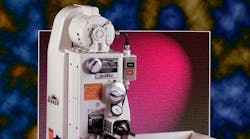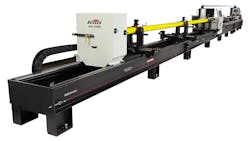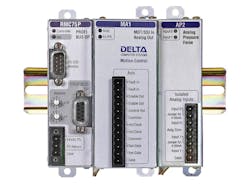Download this article as a .PDF
Older machine designs can be given new life by retrofitting new motion control systems. Such is the case for Sunnen Products Co., St. Louis, and its latest generation of heavy-duty tube honing system, the HTG. Honing is done on the inner walls of oil drilling pipe, hydraulic cylinders, nuclear fuel rods, and other pipe segments to achieve a precision size while reducing metallurgical stress and creating a cross-hatched surface finish.
The HTG machine can hone tubes from 2 to 24 in. inside diameter (ID) in 2-m increments up to 14 m (46 ft) long. Although the original design performed well, the Sunnen team decided to make some control upgrades to enable higher material removal rates and improve operating stability.
The tube honing process can be harsh, noisy, and prone to shock and vibration—sometimes violently. The machine (Fig. 1) puts two hydraulic axes to work: the feed axis and the stroke axis. The stroke axis is powered by a hydraulic motor and chain drive to move the honing tool (Fig. 2) on a drive shaft through the tube.
The feed axis moves a rod within the drive shaft to expand the abrasive tool at the end of the shaft to come into contact with the inside of the tube. The rotation of the honing tool (the spindle axis) is provided by a fixed-speed hydraulic motor and controlled by a PLC. The machine can push the feed rod, aided by mechanical leverage, to apply up to 3,000 lb. of force to the inside of the tube.
Limitations of Previous System
The previous feed system used analog control of a complicated array of hydraulic valves to prompt the honing tool to exert varying amounts of force on the ID the tube. Because of the system’s limited responsiveness to forces encountered in the honing operation, operators had to delicately balance cutting conditions to ensure safe operation. The Sunnen team felt that upgrading to the latest electrohydraulic motion controller could improve reaction to reduce the shock and vibration. The result would be improved productivity and longer machine life.
The decision was made to replace the analog controls with an RMC75P two-axis electro-hydraulic motion controller from Delta Computer Systems. Peter Kwentus, Sunnen’s engineer, had previously used this controller in a tensile-testing machine, so he was familiar with its capabilities and how the machine can be set up.
The controller (Fig. 3), is designed to provide direct interfaces to transducers and proportional servo valves, making system connection and I/O setup easy tasks. The RMC75P also provides a built-in PROFINET interface. Sunnen uses this interface to connect to a supervisory PLC, which seamlessly shares all necessary control variables with the motion controller.
Using Multiple Types of Feedback
“With the Delta controller, we completely simplified the design of the feed controls by using two pressure transducers and one electrohydraulic servovalve,” said Kwentus. The pressure sensors are installed in the feed cylinder on either side of the piston. The difference between the two pressure readings enables the motion controller to track and manage how much force is being applied by the honing tool on the inside of the tube.
In addition, the extension of the honing tool inside the tube is controlled using the position of the feed rod in the stroke tube, which is measured by a magnetostrictive linear displacement transducer (MLDT) mounted in the piston rod of the hydraulic feed cylinder.
The motion controller uses the feedback in different ways during the course of the honing operation. As the honing tool approaches the inner wall of the tube, the motion controller extends the feed axis until it detects that the force being exerted on the tube wall by the honing tool reaches a predetermined level so that honing can begin. The accuracy and flexibility of this control technique allows for very quick engagement without causing damage to the cutting surface.
During the actual honing operation, the motion controller maintains a set amount of force between the honing tool and the tube, all the while monitoring the position of the tool for detecting when the inner wall of the tube is smooth and the desired final diameter has been reached. For the precise tube dimensions to be achieved, the amount of wear on the abrasive stones must also be taken into account.
The Motion Algorithms
The motion algorithms incorporate data from curves and interpolated values from user set points or actual machining conditions. This technique allows any variable to be adjustable in a controlled way based upon the conditions and the control intent. “Delta’s program triggers allowed me to create an additional task for computation only,” said Kwentus. “In this task, I’m able to compute whatever is needed at the speed of the control loop.”
The stroke axis position is measured by a rotary encoder attached to the hydraulic motor drive that operates this axis. The motion controller uses this information to control the extension of the stroke axis into the tube being honed. “Delta’s fast loop time and high resolution inputs and outputs help to keep the process fully in control,” said Kwentus.
Programming the Motion
To program the motion, the Sunnen engineer used Delta’s RMCTools development package, which includes a Plot Manager and Tuning Wizard. The Plot Manager displays the actual motion parameters (e.g., position, velocity, and pressure/force) of each axis against target parameter values, enabling system designers to make changes to control loop parameter gains to tune the motion.
The tuning process can be simplified by running Delta’s Tuning Wizard, which predicts the optimal gain values by exercising the hardware and monitoring the results. “The Tuning Wizard worked great,” said Kwentus. “The RMC75P is so flexible that I could try different control techniques to help me understand the physics of the mechanical system, making the Delta controller a great platform for development.
“By using many of the advanced control features that Delta built into RMCTools, I was able to develop a new feed methodology that has in some cases doubled the rate at which material is removed from the inside of the tube,” he concluded. “The improvements we made are game-changing for our business and customers.”
Jason Palmer is a Certified Fluid Power Hydraulic Specialist and regional manager at Delta Computer Systems Inc., Battle Ground, Wash. For information on Sunnen’s honing machines for hydraulic cylinders and other applications, click here.





